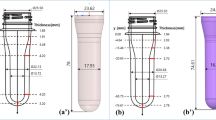Abstract
This paper deals with a multiobjective optimization of a screw-top beverage bottle for hot vending. The bottle body has temperate touch feeling and can be embossed easily by axially imposing a cylindrical tube die with rib-shaped inner surface on the outer surface of the bottle body. Initially, a contact nonlinear analysis of fingers grasping the bottle is carried out, and the amount of heat transmitted from the hot bottle to the flesh of the finger is then calculated to evaluate the hot touch feeling. Meanwhile, the simulation of the rib-shape embossing process of the bottle body is performed to evaluate the embossing formability of different rib shape designs. Finally, using response surface approximation method and weighted sum approach, a multiobjective optimization on the shape of the rib is performed to obtain temperate touch feeling as well as better embossing formability. The amount of heat transmitted from the optimized rib-shape embossed bottle decreased at least 30% as compared with that of the regular bottle.
Similar content being viewed by others
References
Han J, Yamazaki K, Nishiyama S (2004) Optimization of the crushing characteristics of triangulated aluminum beverage cans. Struct Multidiscipl Optim 28(1):47–54
Han J, Itoh R, Nishiyama S, Yamazaki K (2005) Application of structure optimization technique to aluminum beverage bottle design. Struct Multidiscipl Optim 29(4):304–311
Hoon H, Kim S (2001) Optimum process design in sheet-metal forming with finite element analysis. Trans ASME J Eng Mater Technol 123(4):476–481
Kim IY, de Weck OL (2004) Adaptive weighted sum method for multiobjective optimization. In: Proc. 10th AIAA/ISSMO multidisciplinary analysis and optimization conference, AIAA-2004-4322, Albany, New York (in CD-ROM)
Manning T, Gage P, Nguyen J, Haimes R (2004) ComGeom2: a geometry tool for multidisciplinary analysis and data sharing. In: 10th AIAA/ISSMO multidisciplinary analysis and optimization conference, AIAA-2004-4303, Albany, New York (in CD-ROM)
McAllister C, Simpson T (2003) Multidisciplinary robust design optimization of an internal combustion engine. Trans ASME J Mech Des 125(1):124–130
Nishiyama S (2002) Aluminum can recycling in a synthesized closed-loop. Corros Eng 51:381–394
Ohata T, Nakamura Y, Katayama T, Nakamachi E (2003) Development of optimum process design system for sheet fabrication using response surface method. J Mater Process Technol 143(144):667–672
Serina E, Mockensturm E, Mote C Jr, Rempel D (1998) A structural model of the forced compression of the fingertip pulp. J Biomech 31:639–646
Srinivasan M, Dandekar K (1996) An investigation of the mechanics of tactile sense using two-dimensional models of the primate fingertip. Trans ASME J Biomech Eng 118:48–55
Suzuki K, Nishihara T (2004) The design of surface shape of resin considering tactile sensation. In: Proc. 3rd China–Japan–Korea joint symposium on optimization of structural and mechanical systems, Kanazawa, Japan. pp 329–334
Ueno H (2003) Drinks cans with customer convenience. In: Proceedings of the Canmaker Summit, Singapore (in CD-ROM)
Yamazaki K, Han J (1998) Maximization of the crushing energy absorption of tubes. Struct Optim 16(1):37–46
Yun YB, Nakayama H, Tanino T, Arakawa M (2001) Generation of efficient frontiers in multiobjective optimization problems by generalized data envelopment analysis. Eur J Oper Res 129(3):586–595
Author information
Authors and Affiliations
Corresponding author
Rights and permissions
About this article
Cite this article
Han, J., Yamazaki, K., Itoh, R. et al. Multiobjective optimization of a two-piece aluminum beverage bottle considering tactile sensation of heat and embossing formability. Struct Multidisc Optim 32, 141–151 (2006). https://doi.org/10.1007/s00158-005-0563-8
Received:
Revised:
Published:
Issue Date:
DOI: https://doi.org/10.1007/s00158-005-0563-8




